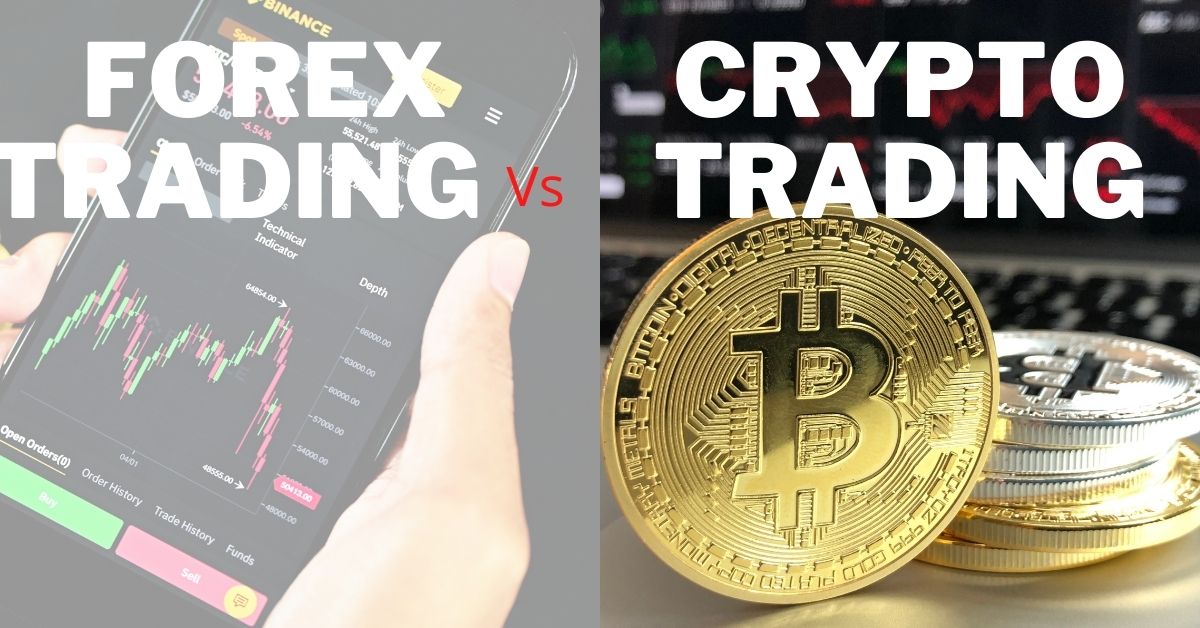Hey there, curious about forex trading vs crypto trading? I totally get it—these markets can seem pretty similar at first glance, especially since you can trade both on many of the same platforms. Let’s have a chat about what makes each unique and which might be the better fit for your trading style.
Looking to grow your investment portfolio or perhaps find a new income stream? You’re exploring two of the most accessible yet fundamentally different financial markets available today. With forex moving over $7 trillion daily and crypto continuing its revolutionary impact on finance, the opportunities are substantial—but so are the risks.
Whether you’re a complete beginner wondering where to start or an experienced trader looking to diversify, understanding the distinct characteristics of each market is crucial. From volatility and regulation to trading hours and profit potential, your success depends on choosing the path that aligns with your financial goals, risk tolerance, and trading personality. In this guide, we’ll cut through the jargon and give you practical insights to make an informed decision about forex trading vs crypto trading and which market deserves your time and capital.
Basics of Forex Trading Vs Crypto Trading
Think of crypto as the new kid on the financial block, while forex is like the established neighborhood leader. Crypto trading is actually a subset of what happens in the broader forex world. When you trade crypto, you’re dealing specifically with digital currencies like Bitcoin and Ethereum. Forex, meanwhile, encompasses all the world’s traditional currencies—dollars, euros, yen, you name it.
But here’s where it gets interesting: despite some surface-level similarities, they operate in completely different ecosystems with unique rules, risks, and opportunities. We will take a deeper look at all the different aspects of forex trading vs crypto trading.
Forex Trading: The World’s Financial Playground
So what exactly is forex? It’s short for “foreign exchange,” and it’s absolutely massive—we’re talking over $7 trillion changing hands every single day! That makes it the largest, most liquid financial market on the planet.
When you trade forex, you’re essentially betting on how one currency will perform against another. For example, if you think the euro will strengthen against the US dollar, you’d buy the EUR/USD pair. If you’re right, you profit; if not, you lose.
What’s it like to trade forex?
Imagine you’re watching economic news and notice that the European Central Bank is likely to raise interest rates while the US Federal Reserve is holding steady. You might think, “The euro’s going to get stronger!” So you buy €10,000 worth of EUR/USD at 1.10 (costing you $11,000). If the exchange rate moves to 1.15, your euros are now worth $11,500—giving you a $500 profit when you sell.
What makes forex particularly interesting is how it’s influenced by everything from political stability to employment reports. Remember Brexit? The British pound took a nosedive after that vote—creating both dangers and opportunities for forex traders.
Advantages of trading forex
- Liquidity like no other: Want to trade $1 million worth of currencies? No problem—the market barely notices.
- Trading around your schedule: Markets are open 24 hours a day, five days a week, following the sun around the globe from Sydney to New York.
- Leverage that can supercharge returns: Many brokers offer 30:1 or even 50:1 leverage, meaning you can control $50,000 worth of currency with just $1,000 of your own money.
- Stability (relatively speaking): Major currency pairs like EUR/USD typically move less than 1% daily—making them more predictable than their crypto cousins.
- Regulation you can count on: Major forex markets have robust regulatory frameworks, giving you some protection against fraud like CMA in Kenya
Disadvantages of Forex trading
- Leverage cuts both ways: that same leverage that boosts profits can absolutely decimate your account when trades go wrong.
- Complexity that can overwhelm: economic reports, interest rate decisions, geopolitical events—it’s a lot to keep track of.
- Broker issues: Not all forex brokers are created equal, and some engage in practices that put you at a disadvantage. In Kenya, look out for CMA-regulated brokers to ensure the safety of your funds.
Crypto Trading: The Digital Wild West
Now let’s talk crypto. Unlike forex, which has been around for decades, cryptocurrency trading is relatively new, emerging with Bitcoin in 2009. Crypto exists on decentralized blockchain networks, operating independently of banks or governments.
When you trade crypto, you’re dealing with digital assets that can function as currencies, investment vehicles, or even access tokens to specific blockchain applications. It’s a whole new financial frontier.
What’s it like to trade crypto?
Let’s say you’ve been reading about Ethereum’s upcoming network upgrade. You believe this will make the network more efficient and drive up the price, so you buy 5 ETH at $3,000 each. Two weeks later, after the upgrade is successfully implemented, the price jumps to $3,500 per ETH. You decide to sell, walking away with a $2,500 profit.
But here’s the thing about crypto—that same scenario could play out completely differently. The upgrade might hit technical snags, sending the price plummeting to $2,500 instead, leaving you with a $2,500 loss. The volatility in crypto is no joke!
Advantages of trading cryptocurrencies
- Markets never close: Crypto trades 24/7/365—holidays, weekends, middle of the night, doesn’t matter.
- True ownership: With self-custody wallets, you genuinely own your assets, not just a contract with a broker.
- Friendlier fees: While not free, crypto trading generally costs less than forex in terms of spreads and commissions.
- Explosive growth potential: Some cryptocurrencies have delivered returns that would make even the most successful forex trader’s jaw drop.
- Innovation at light speed: DeFi, NFTs, yield farming—crypto offers financial applications that simply don’t exist in the traditional world.
Disadvantages
- Volatility that’ll make your head spin: 10-20% price swings in minutes are not uncommon.
- Security nightmares: From exchange hacks to phishing scams, the crypto world is full of security challenges.
- Regulation that’s playing catch-up: The regulatory landscape for crypto is still developing, leaving traders with less protection.
- Market manipulation concerns: With lower liquidity than forex, some crypto markets are vulnerable to manipulation.
Forex trading Vs Crypto Trading Key Differences
Let’s break down the key differences that might affect your trading experience:
Trading Hours: Forex gives you nights and weekends off (maybe a good thing for work-life balance?), while crypto never stops—which can be both a blessing and a curse.
Market Size: Forex’s $7 trillion daily volume dwarfs crypto’s approximately $100 billion. This means forex prices are generally more stable and harder to manipulate.
Volatility: If forex is like sailing on a lake, crypto is white-water rafting. The average daily volatility for major forex pairs is 0.5-1%, while Bitcoin might move 5-10% in a day, and smaller altcoins can swing even more dramatically.
Technical Analysis: Forex has decades of pattern data that traders rely on. Crypto charts are younger and sometimes less reliable for technical analysis.
Fundamental Analysis: Forex traders watch economic indicators like GDP and inflation. Crypto traders look at metrics like active addresses, developer activity, and token economics.
Learning Curve: Both have steep learning curves, but forex’s established educational resources might make it easier for beginners to find reliable information.
Who Should Choose What?
Based on my experience talking with traders, here’s my take on who might prefer each market:
Forex might be your jam if:
- You prefer analyzing economic trends and have a background in finance or economics
- You want a balance between opportunity and stability
- You value regulatory protection and established trading protocols
- You’re comfortable with moderate leverage and prefer predictable trading hours
- You’re patient and can be satisfied with smaller, more consistent gains
Crypto might be right up your alley if:
- You’re tech-savvy and excited about blockchain technology’s potential
- You have a higher risk tolerance and don’t mind stomach-churning volatility
- You want more flexibility in trading hours and enjoy the always-on nature of the market
- You’re interested in more than just trading—perhaps also in staking, yield farming, or using DeFi applications
- You believe in the long-term potential of digital assets to transform finance
Things to Consider Before Diving In.
Whether you choose forex or crypto (or both!), here are some hard-won truths that apply to either path:
-
Start small, really small: Don’t risk money you can’t afford to lose, especially when you’re just learning. Many successful traders begin with as little as $100-500 in forex or $50-200 in crypto.
Remember that 70-80% of retail traders lose money in their first year, so consider your initial capital as the cost of your financial education.
-
Education before allocation: Invest time in learning before you invest money in trading. Spend at least 3-4 weeks studying market fundamentals, technical analysis, and risk management.
Free resources like BabyPips for forex or Binance Academy for crypto can provide structured learning. The $100 you might lose from rushing in unprepared could instead buy you several quality trading books or courses.
It is however advised to join a professional forex or crypto trading academy to get first hand insights from the professionals. This will give you more confidence and understanding of the market. -
Emotional control is everything: Both markets will test your psychological resilience. Develop a trading plan and stick to it. Trading psychology is responsible for approximately 80% of your success.
Many traders report that maintaining a trading journal to document not just trades but emotional states helps them identify destructive patterns like revenge trading after losses or overconfidence after wins.
-
Risk management isn’t optional: Use stop-losses and position sizing, and never risk more than a small percentage of your capital on any single trade. Professional traders typically risk only 1-2% per trade, meaning on a $1,000 account, your maximum loss should be $10-20 per position.
Without proper risk management, even traders with 70% win rates can blow their accounts if their losing trades are significantly larger than their winning ones. -
Demo accounts are your friends: Practice with paper trading before putting real money on the line. Most successful traders spend 3-6 months on demo accounts before transitioning to real money. This practice period allows you to test different strategies without emotional attachment and helps you develop the discipline needed when actual funds are at stake. Statistical data shows that traders who spend adequate time on demo accounts have a significantly higher chance of profitability in their first year of live trading.
-
Understand your trading personality: Different markets and timeframes suit different temperaments. Day trading requires quick decision-making and comfort with technology, while swing trading demands patience and analytical skills.
Take personality assessments specifically designed for traders to understand if you’re better suited for the more structured forex environment or the innovative but volatile crypto space.
-
Build a proper trading environment: Create a distraction-free space with reliable internet, proper charting tools, and possibly multiple monitors. Many traders attribute improved performance to having a dedicated trading setup that puts them in the right mindset and minimizes technical issues during critical market movements.
Conclusion
There’s no one-size-fits-all answer to whether forex or crypto trading is “better.” It depends entirely on your goals, risk tolerance, interests, and trading style. Some traders even participate in both markets, applying different strategies to each.
Whatever you decide, remember that successful trading is a marathon, not a sprint. Take your time to learn, start small, and gradually build your skills and confidence.
Ready to make your choice? The trading world awaits—just make sure you’re entering with your eyes wide open and your expectations in check!

